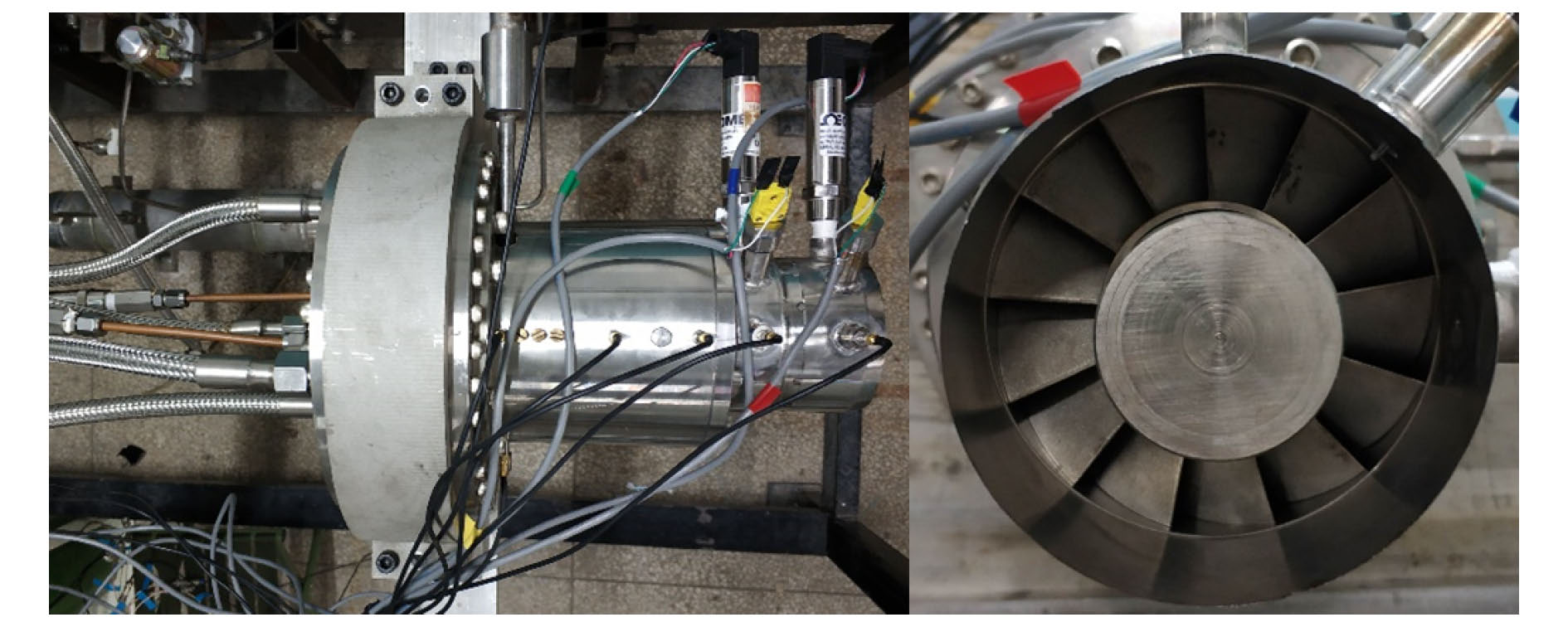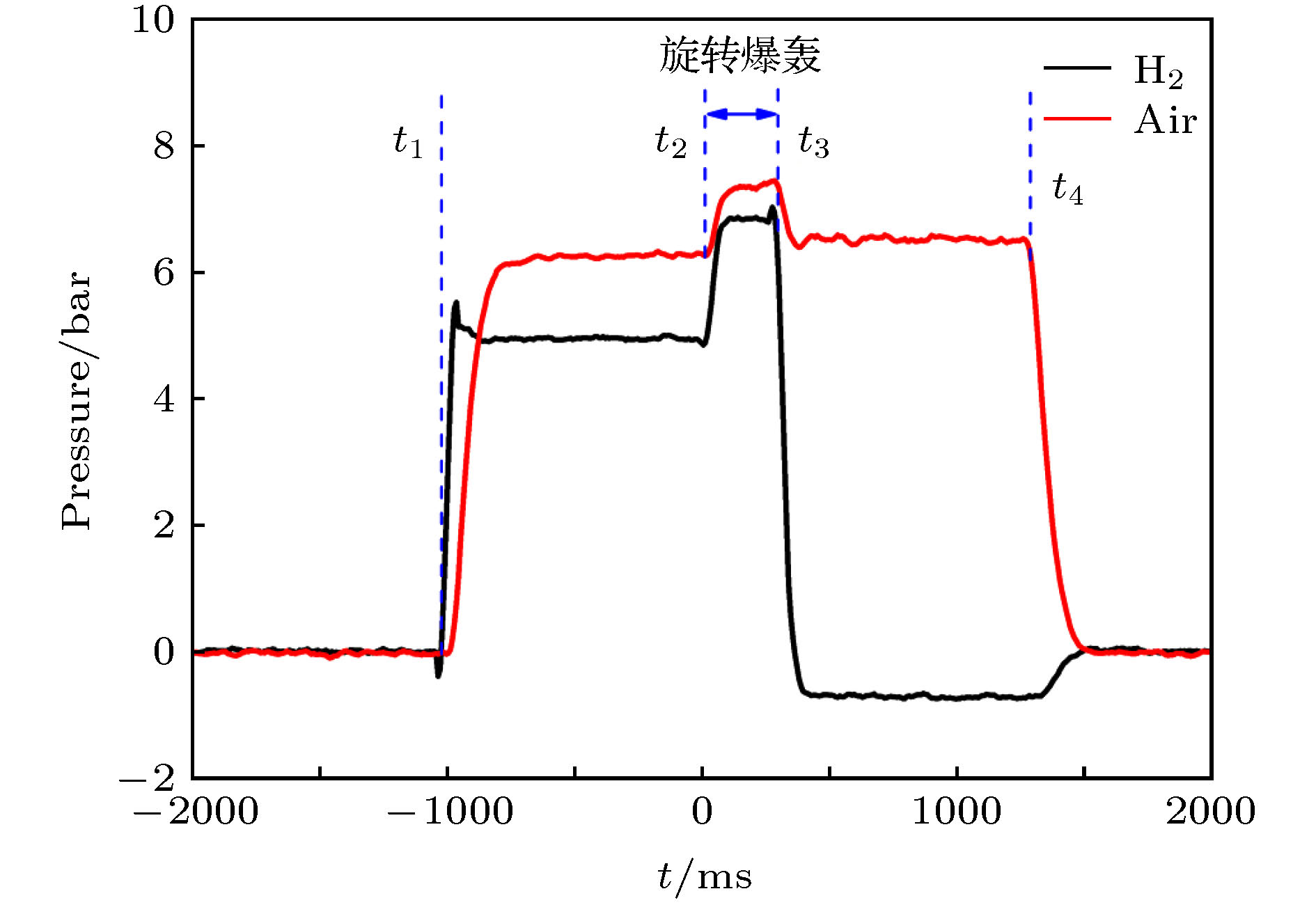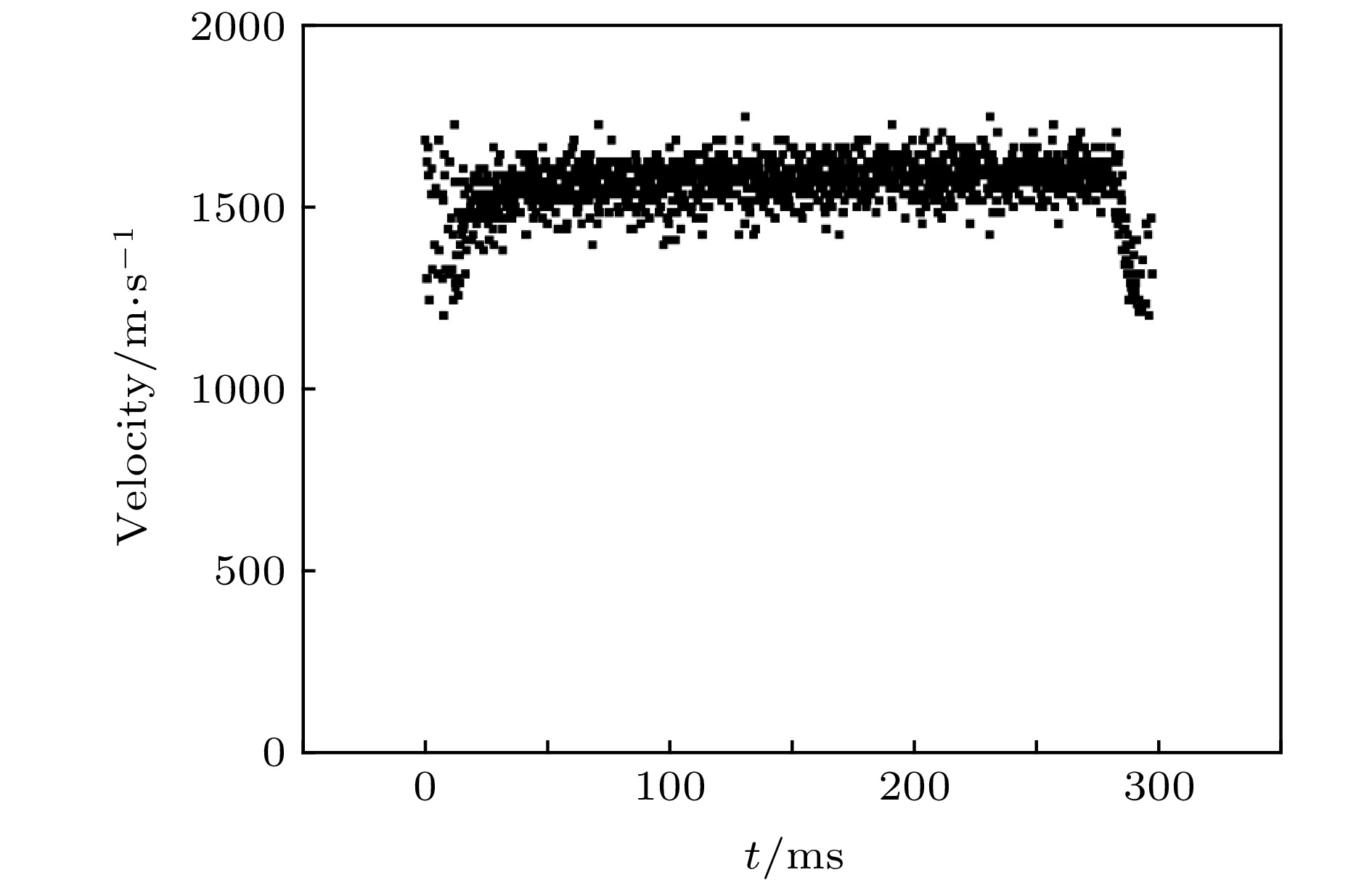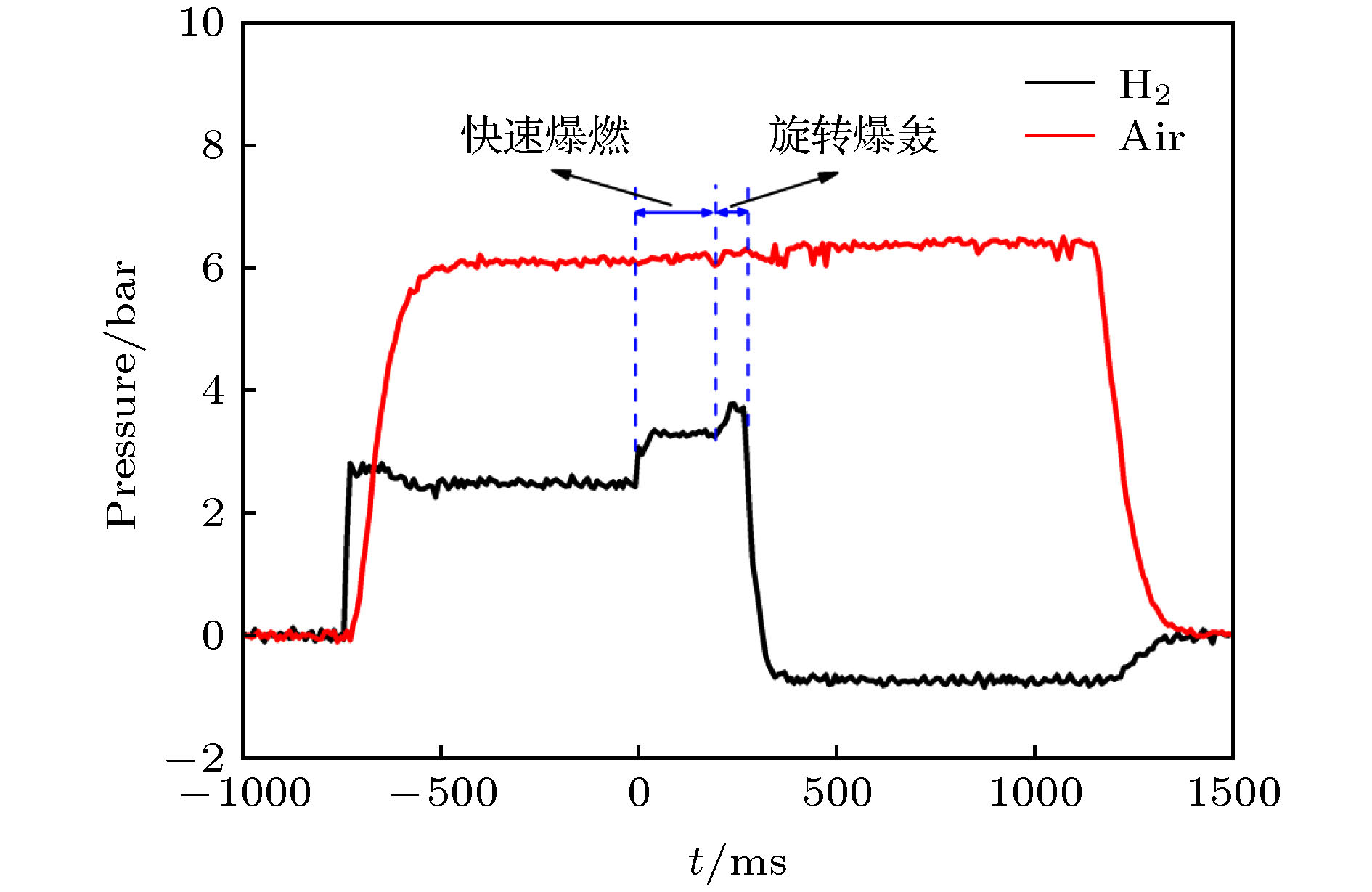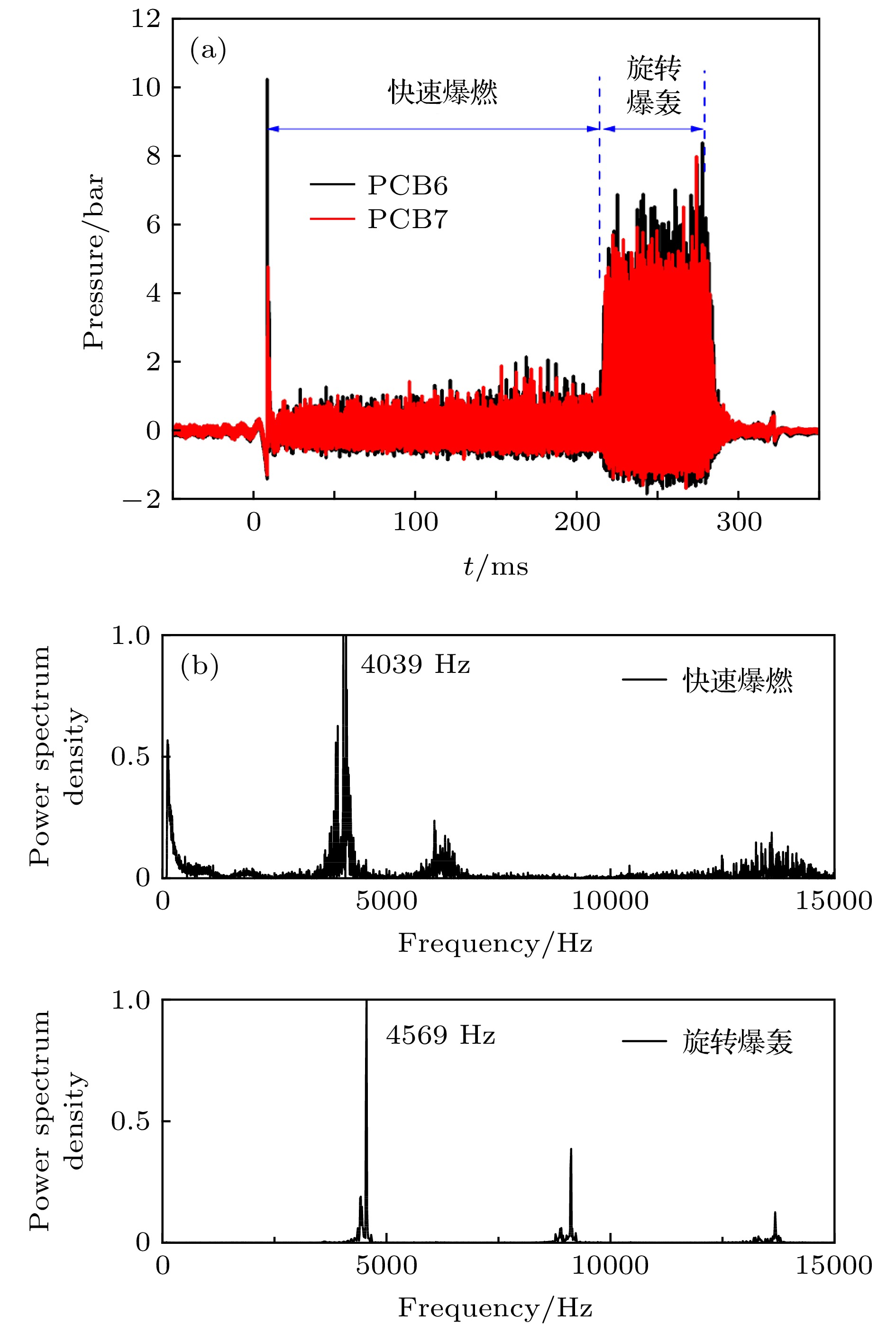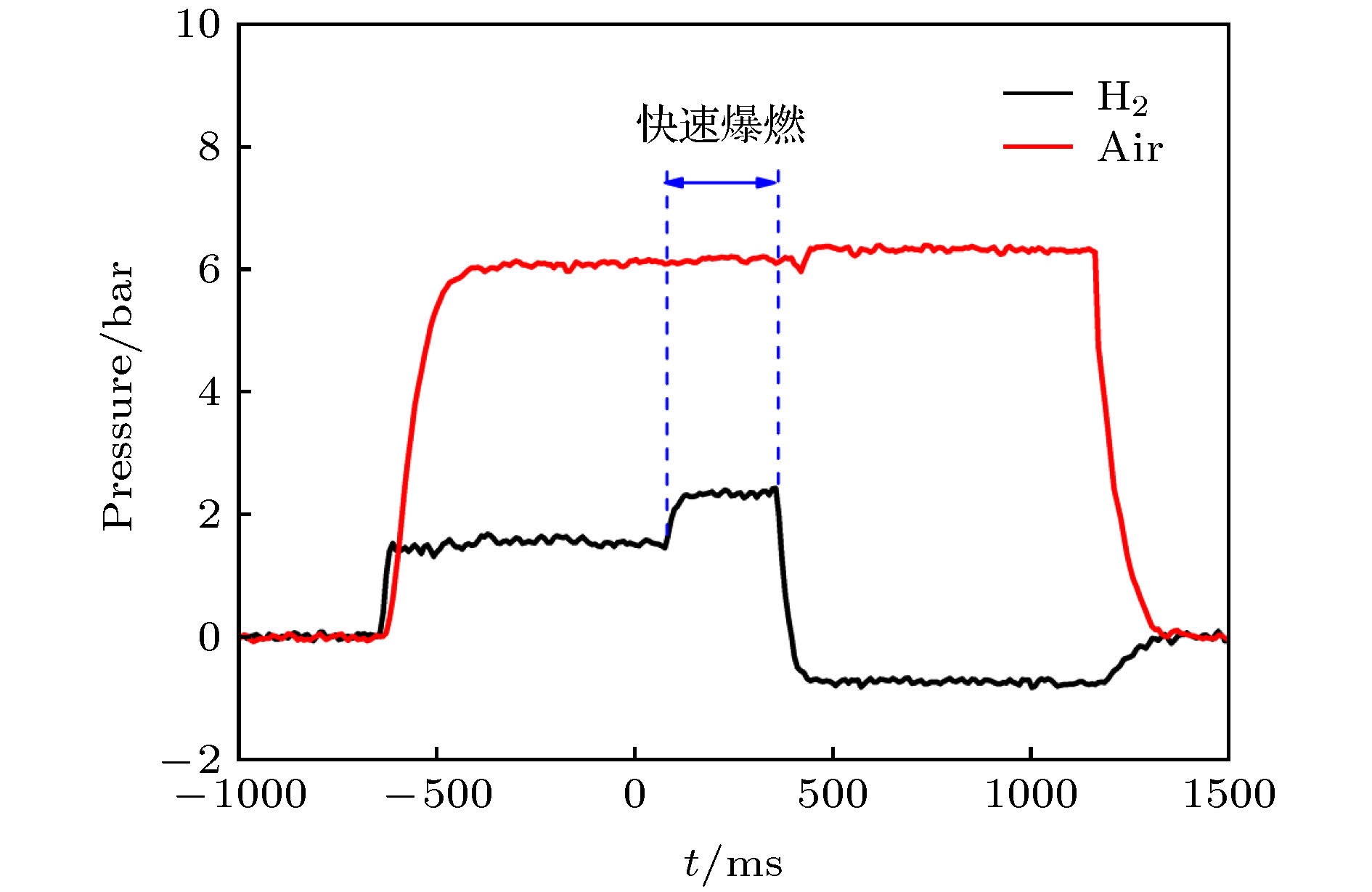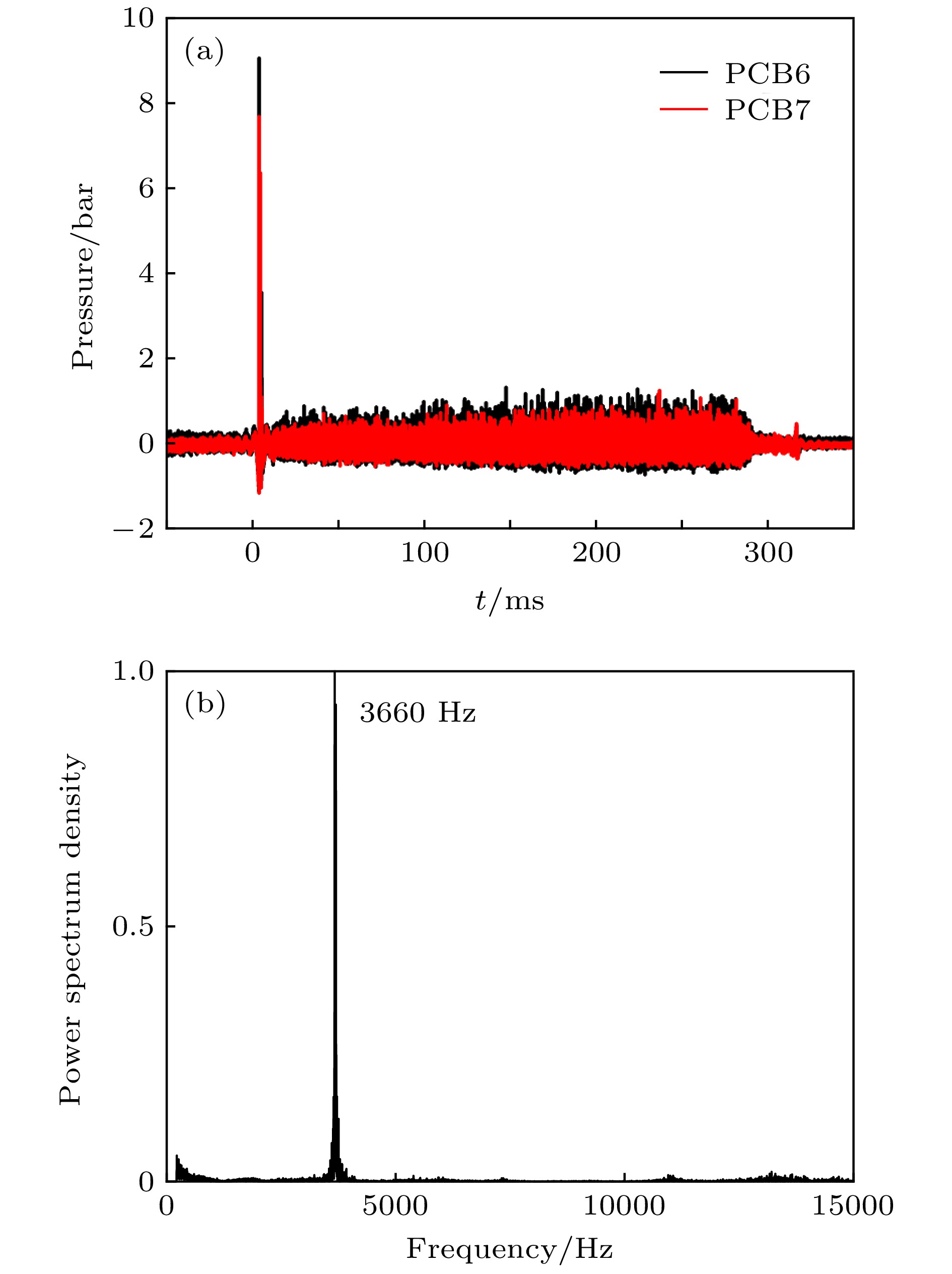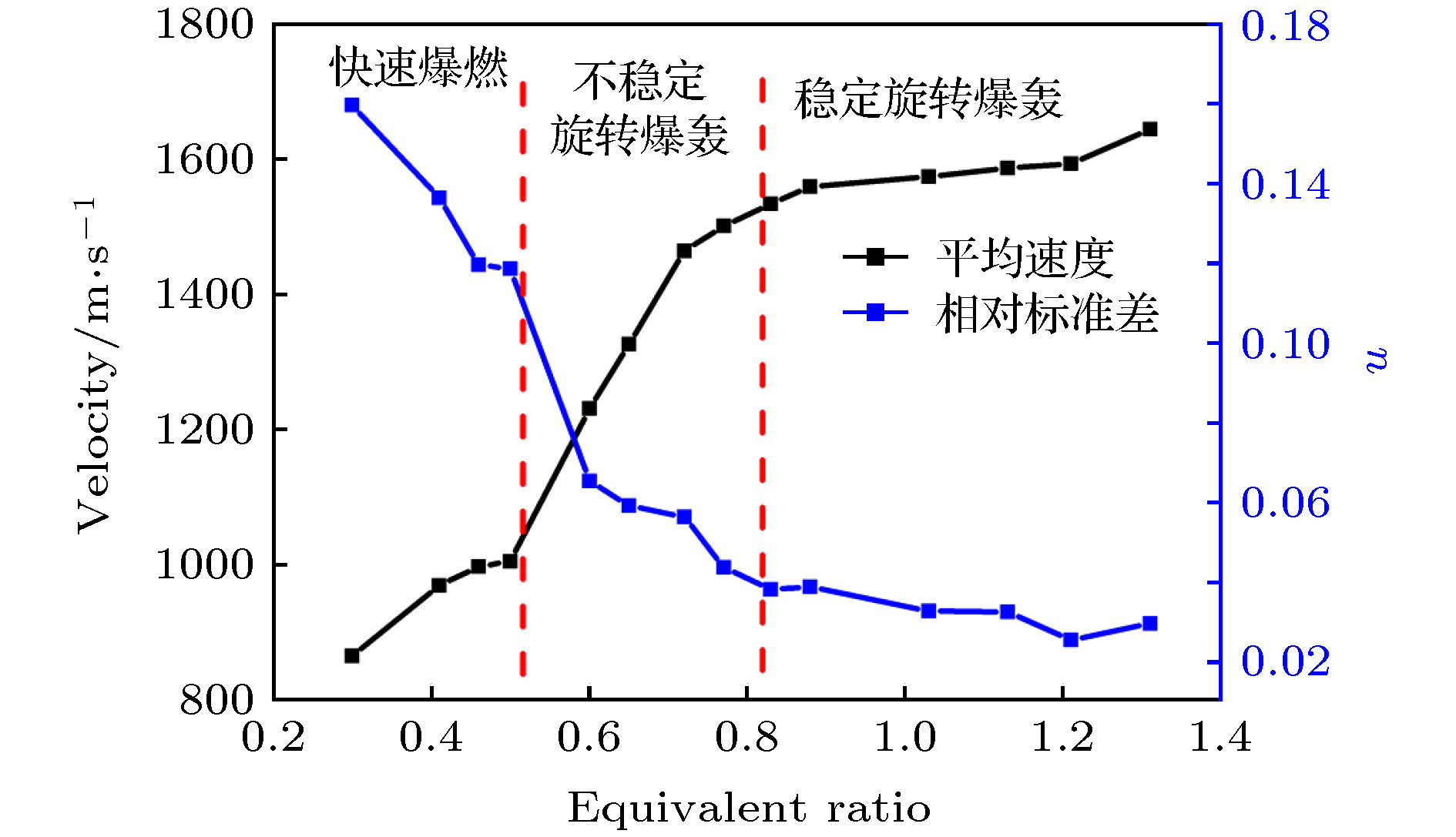-
为了研究涡轮导向器对旋转爆轰波传播特性的影响, 以氢气为燃料, 空气为氧化剂, 在不同当量比下开展了实验研究. 基于高频压力传感器及静态压力传感器的信号, 详细分析了带涡轮导向器的旋转爆轰燃烧室的工作模式以及涡轮导向器对非均匀不稳定爆轰产物的影响. 实验结果表明: 在当量比较低时, 爆轰燃烧室以快速爆燃模式工作; 逐渐增大当量比, 爆轰燃烧室开始以不稳定旋转爆轰模式工作; 继续增大当量比, 爆轰燃烧室以稳定旋转爆轰模式工作, 且旋转爆轰波的传播速度和稳定性均随当量比的增大逐渐提高. 爆轰波下游的斜激波与涡轮导向器相互作用, 涡轮导向器对压力振荡的幅值具有明显的抑制作用, 但对压力振荡频率的影响较小. 随着当量比的增大, 涡轮导向器上下游的静压均同时增大, 经过涡轮导向器的作用, 涡轮下游静压明显降低.Detonation is a supersonic combustion in which a shock wave propagates driven by an energy release in a reaction zone. Compared with deflagration, detonation has high thermodynamic efficiency and fast heat release rate. The traditional propulsion system based on the isostatic combustion is relatively mature, and its performance is very difficult to further improve. Therefore, detonation is expected to improve the performance of the propulsion system. Replacing the isobaric combustion chamber of turbojet engine with rotating detonation combustor can not only improve the combustion chamber efficiency, but also reduce the number of compressor stages, reduce the weight of engine and simplify the structure of engine. In order to study the operation characteristics of rotating detonation combustor with a turbine guide vane, a series of experiments is conducted, with hydrogen used as fuel and air as oxidant at different equivalence ratios. Based on the signals of high frequency pressure sensor and static pressure sensor, the operation mode of rotating detonation combustor and the effect of a turbine guide vane on the inhomogeneous and unstable detonation products are analyzed in detail. The experimental results show that when the equivalent ratio is less than 0.5, the rotating detonation combustor operates in a rapid deflagration mode and the pressure of combustion wave is about 0.6 bar (1 bar = 105 Pa). The rotating detonation combustor begins to operate in an unstable rotating detonation mode when the equivalence ratio increases to 0.6, and the pressure of detonation wave is about 6 bar. The rotating detonation combustor operates in a stable rotating detonation mode when the equivalence ratio reaches 0.82, and the pressure of detonation wave is about 16.3 bar. In addition, the propagation velocity gradually increases and the stability improves with the increase of the equivalence ratio. The oblique shock wave interacts with the turbine guide vane, and part of the oblique shock wave is reflected back to combustor, which causes some small pressure fluctuations in combustor. The turbine guide vane can obviously suppress the amplitude of pressure oscillation, but has little effect on the frequency of pressure oscillation. The upstream and downstream static pressure of the turbine guide vane increase simultaneously with equivalence ratio increasing. Furthermore, the static pressure of detonation products decreases obviously after passing through the turbine guide vane.
-
Keywords:
- rotating detonation combustor /
- turbine guide vane /
- operation characteristics /
- oscillation pressure
[1] Rankin B A, Fotia M L, Naples A G, Stevens C A, Hoke J L, Kaemming T A, Theuerkauf S W, Schauer F R 2017 J. Propul. Power 33 131
 Google Scholar
Google Scholar
[2] Wolański P 2013 Proc. Combust. Inst. 34 125
 Google Scholar
Google Scholar
[3] Anand V, Gutmark E 2019 Prog. Energy Combust. 73 182
 Google Scholar
Google Scholar
[4] Zhou R, Wu D, Wang J P 2016 Chin. J. Aeronaut. 29 15
 Google Scholar
Google Scholar
[5] Yang C L, Wu X S, Ma H, Peng L, Gao J 2016 Exp. Therm Fluid Sci. 71 154
 Google Scholar
Google Scholar
[6] Bykovskii F A, Zhdan S A, Vedernikov E F 2014 Combust. Explos.Shock Waves 50 214
 Google Scholar
Google Scholar
[7] Fotia M L, Hoke J, Schauer F 2018 Exp. Therm Fluid Sci. 94 345
 Google Scholar
Google Scholar
[8] Ma Z, Zhang S J, Luan M Y, Yao S B, Xia Z J, Wang J P 2018 Int. J. Hydrogen Energy 43 18521
 Google Scholar
Google Scholar
[9] Stechmann D P, Sardeshmukh S, Heister S D, Mikoshiba K 2019 J. Propul. Power 35 125
 Google Scholar
Google Scholar
[10] Bluemner R, Bohon M D, Paschereit C O, Gutmark E J 2019 Int. J. Hydrogen Energy 44 7628
 Google Scholar
Google Scholar
[11] Li B X, Wu Y W, Weng C S, Zheng Q, Wei W L 2018 Exp. Therm Fluid Sci. 93 366
 Google Scholar
Google Scholar
[12] Lin W, Zhou J, Liu S J, Lin Z Y, Zhuang F C 2015 Int. J. Hydrogen Energy 40 1980
 Google Scholar
Google Scholar
[13] Anand V, St George A, Gutmark E 2017 Int. J. Hydrogen Energy 42 12629
 Google Scholar
Google Scholar
[14] Anand V, St George A, Driscoll R, Gutmark E 2015 Int. J. Hydrogen Energy 40 16649
 Google Scholar
Google Scholar
[15] Xie Q F, Wang B, Wen H C, He W 2019 J. Propul. Power 35 141
 Google Scholar
Google Scholar
[16] Xie Q F, Wen H C, Li W H, Ji Z F, Wang B, Wolanski P 2018 Energy 151 408
 Google Scholar
Google Scholar
[17] Wen H C, Xie Q F, Wang B 2019 Combust. Flame 210 389
 Google Scholar
Google Scholar
[18] Sun J, Zhou J, Liu S, Lin Z, Lin W 2018 Aerosp. Sci. Technol. 81 383
 Google Scholar
Google Scholar
[19] Frolov S M, Aksenov V S, Ivanov V S, Shamshin I O 2015 Int. J. Hydrogen Energy 40 1616
 Google Scholar
Google Scholar
[20] Tsuboi N, Watanabe Y, Kojima T, Hayashi A K 2015 Proc. Combust. Inst. 35 2005
 Google Scholar
Google Scholar
[21] Jourdaine N, Tsuboi N, Ozawa K, Kojima T, Koichi Hayashi A 2019 Proc. Combust. Inst. 37 3443
 Google Scholar
Google Scholar
[22] Anand V, St George A, Driscoll R, Gutmark E 2016 Int. J. Hydrogen Energy 41 1281
 Google Scholar
Google Scholar
[23] Sousa J, Paniagua G, Collado Morata E 2017 Appl. Energy 195 247
 Google Scholar
Google Scholar
[24] Ji Z F, Zhang H Q, Wang B 2019 Aerosp. Sci. Technol. 92 806
 Google Scholar
Google Scholar
[25] Ishiyama C, Miyazaki K, Nakagami S, Matsuoka K, Kasahara J, Matsuo A, Funaki I 2016 52nd AIAA/SAE/ASEE Joint Propulsion Conference Salt Lake City, USA, July 25−27, 2016 p5103
[26] Higashi J, Nakagami S, Matsuoka K, Kasahara J, Matsuo A, Funaki I, Moriai H 2017 55th AIAA Aerospace Sciences Meeting Grapevine, USA, January 9−13, 2017 p1286
[27] Naples A, Hoke J, Battelle R, Schauer F 2019 J. Eng. Gas Turbines Power 141 021029
 Google Scholar
Google Scholar
[28] Bach E, Bohon M D, Paschereit C O, Stathopoulos P 2018 AIAA Propulsion and Energy Forum Cincinnati, USA, July 9−11, 2018 p4479
[29] Welsh D J, King P I, Debarmore N D, Schauer F R, Hoke J L 2014 AIAA SciTech National Harbor, USA, January 13−17, 2014 p1316
[30] Zhou S B, Ma H, Li S, Liu D K, Yan Y, Zhou C S 2017 Int. J. Hydrogen Energy 42 20297
 Google Scholar
Google Scholar
[31] Zhou S, Ma H, Ma Y, Zhou C S, Liu D K, Li S 2018 Acta Astronaut. 151 7
 Google Scholar
Google Scholar
[32] Wolański P 2015 Appl. Mech. Mater. 782 3
 Google Scholar
Google Scholar
-
表 1 实验工况表
Table 1. Test conditions.
工况 氢气流量/g·s–1 空气流量/g·s–1 当量比 工作模式 1 3.8 438 0.30 快速爆燃 2 5.2 437 0.41 快速爆燃 3 5.7 438 0.45 快速爆燃 4 6.3 437 0.50 快速爆燃 5 7.6 438 0.60 不稳定爆轰 6 8.2 439 0.65 不稳定爆轰 7 9.0 436 0.72 不稳定爆轰 8 9.5 438 0.75 不稳定爆轰 9 10.4 439 0.82 稳定爆轰 10 11.1 438 0.88 稳定爆轰 11 12.9 436 1.03 稳定爆轰 12 14.2 438 1.13 稳定爆轰 13 15.4 439 1.22 稳定爆轰 14 16.5 437 1.31 稳定爆轰 -
[1] Rankin B A, Fotia M L, Naples A G, Stevens C A, Hoke J L, Kaemming T A, Theuerkauf S W, Schauer F R 2017 J. Propul. Power 33 131
 Google Scholar
Google Scholar
[2] Wolański P 2013 Proc. Combust. Inst. 34 125
 Google Scholar
Google Scholar
[3] Anand V, Gutmark E 2019 Prog. Energy Combust. 73 182
 Google Scholar
Google Scholar
[4] Zhou R, Wu D, Wang J P 2016 Chin. J. Aeronaut. 29 15
 Google Scholar
Google Scholar
[5] Yang C L, Wu X S, Ma H, Peng L, Gao J 2016 Exp. Therm Fluid Sci. 71 154
 Google Scholar
Google Scholar
[6] Bykovskii F A, Zhdan S A, Vedernikov E F 2014 Combust. Explos.Shock Waves 50 214
 Google Scholar
Google Scholar
[7] Fotia M L, Hoke J, Schauer F 2018 Exp. Therm Fluid Sci. 94 345
 Google Scholar
Google Scholar
[8] Ma Z, Zhang S J, Luan M Y, Yao S B, Xia Z J, Wang J P 2018 Int. J. Hydrogen Energy 43 18521
 Google Scholar
Google Scholar
[9] Stechmann D P, Sardeshmukh S, Heister S D, Mikoshiba K 2019 J. Propul. Power 35 125
 Google Scholar
Google Scholar
[10] Bluemner R, Bohon M D, Paschereit C O, Gutmark E J 2019 Int. J. Hydrogen Energy 44 7628
 Google Scholar
Google Scholar
[11] Li B X, Wu Y W, Weng C S, Zheng Q, Wei W L 2018 Exp. Therm Fluid Sci. 93 366
 Google Scholar
Google Scholar
[12] Lin W, Zhou J, Liu S J, Lin Z Y, Zhuang F C 2015 Int. J. Hydrogen Energy 40 1980
 Google Scholar
Google Scholar
[13] Anand V, St George A, Gutmark E 2017 Int. J. Hydrogen Energy 42 12629
 Google Scholar
Google Scholar
[14] Anand V, St George A, Driscoll R, Gutmark E 2015 Int. J. Hydrogen Energy 40 16649
 Google Scholar
Google Scholar
[15] Xie Q F, Wang B, Wen H C, He W 2019 J. Propul. Power 35 141
 Google Scholar
Google Scholar
[16] Xie Q F, Wen H C, Li W H, Ji Z F, Wang B, Wolanski P 2018 Energy 151 408
 Google Scholar
Google Scholar
[17] Wen H C, Xie Q F, Wang B 2019 Combust. Flame 210 389
 Google Scholar
Google Scholar
[18] Sun J, Zhou J, Liu S, Lin Z, Lin W 2018 Aerosp. Sci. Technol. 81 383
 Google Scholar
Google Scholar
[19] Frolov S M, Aksenov V S, Ivanov V S, Shamshin I O 2015 Int. J. Hydrogen Energy 40 1616
 Google Scholar
Google Scholar
[20] Tsuboi N, Watanabe Y, Kojima T, Hayashi A K 2015 Proc. Combust. Inst. 35 2005
 Google Scholar
Google Scholar
[21] Jourdaine N, Tsuboi N, Ozawa K, Kojima T, Koichi Hayashi A 2019 Proc. Combust. Inst. 37 3443
 Google Scholar
Google Scholar
[22] Anand V, St George A, Driscoll R, Gutmark E 2016 Int. J. Hydrogen Energy 41 1281
 Google Scholar
Google Scholar
[23] Sousa J, Paniagua G, Collado Morata E 2017 Appl. Energy 195 247
 Google Scholar
Google Scholar
[24] Ji Z F, Zhang H Q, Wang B 2019 Aerosp. Sci. Technol. 92 806
 Google Scholar
Google Scholar
[25] Ishiyama C, Miyazaki K, Nakagami S, Matsuoka K, Kasahara J, Matsuo A, Funaki I 2016 52nd AIAA/SAE/ASEE Joint Propulsion Conference Salt Lake City, USA, July 25−27, 2016 p5103
[26] Higashi J, Nakagami S, Matsuoka K, Kasahara J, Matsuo A, Funaki I, Moriai H 2017 55th AIAA Aerospace Sciences Meeting Grapevine, USA, January 9−13, 2017 p1286
[27] Naples A, Hoke J, Battelle R, Schauer F 2019 J. Eng. Gas Turbines Power 141 021029
 Google Scholar
Google Scholar
[28] Bach E, Bohon M D, Paschereit C O, Stathopoulos P 2018 AIAA Propulsion and Energy Forum Cincinnati, USA, July 9−11, 2018 p4479
[29] Welsh D J, King P I, Debarmore N D, Schauer F R, Hoke J L 2014 AIAA SciTech National Harbor, USA, January 13−17, 2014 p1316
[30] Zhou S B, Ma H, Li S, Liu D K, Yan Y, Zhou C S 2017 Int. J. Hydrogen Energy 42 20297
 Google Scholar
Google Scholar
[31] Zhou S, Ma H, Ma Y, Zhou C S, Liu D K, Li S 2018 Acta Astronaut. 151 7
 Google Scholar
Google Scholar
[32] Wolański P 2015 Appl. Mech. Mater. 782 3
 Google Scholar
Google Scholar
计量
- 文章访问数: 12462
- PDF下载量: 106
- 被引次数: 0













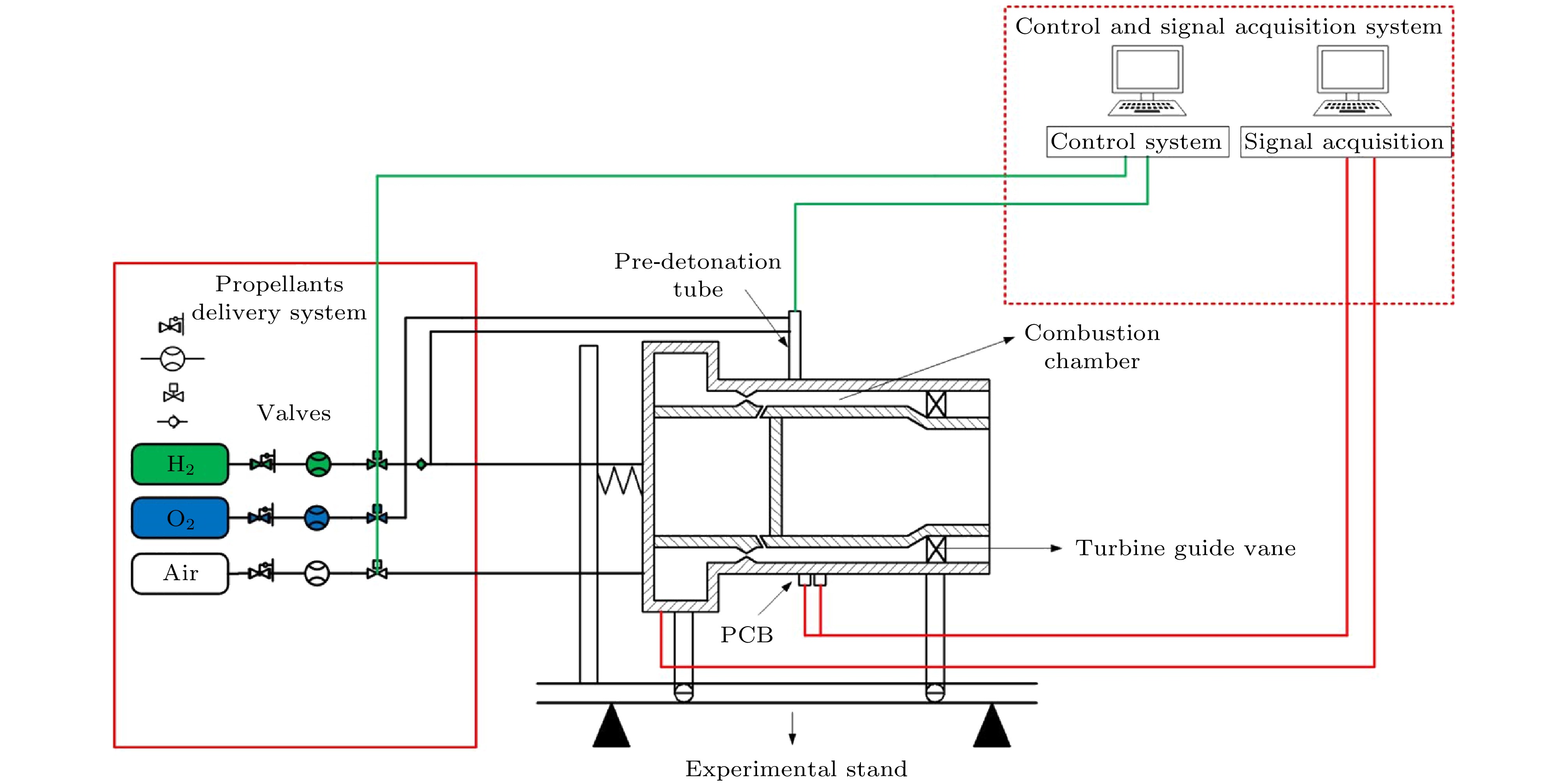
 下载:
下载:
